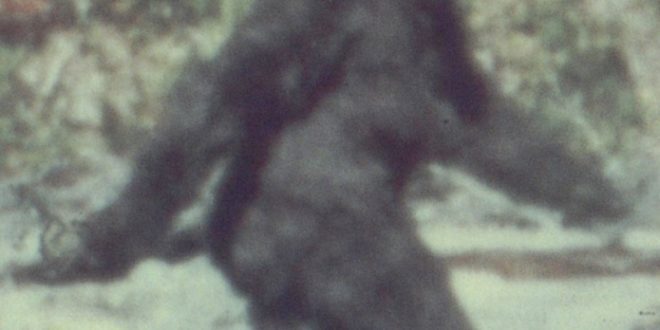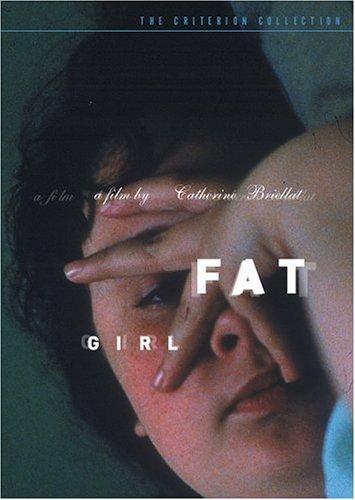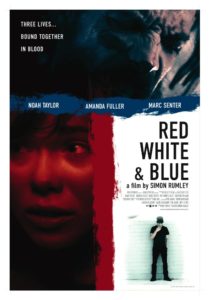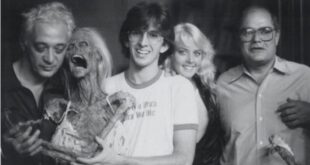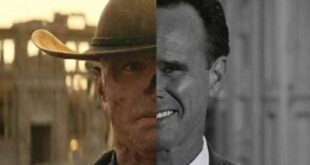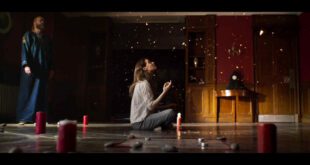6. Eraserhead (1977)

Since we’re in the gray wonderland of “almost” here, it’d be weird if this wasn’t on this Almost Top Five list, so here’s #6. The directorial debut of David Lynch, Eraserhead, has the fascinating distinction of being a movie solely about mood. David Lynch has proven throughout his career to be King of The Uncanny. He has a gift for dismantling the every day and exposing some primal terror underneath it, and that’s the magic of Eraserhead. It’s all about the anxiety of dating, marriage, and raising a family.
If all the romantic comedies were honest about how weird it feels to meet your girlfriend’s parents, they’d all be Eraserhead. If all the dramas were honest about how anxious it is to raise a child, they’d all be Eraserhead. David Lynch presents, with this film, the mythologized version of young love’s awkwardness. It’s Meet the Parents (2000) but in Hell.
Now, for those genre police who might pull this article over and ask for my horror license, I ask you to watch the film again and really hear the sound design, see the stark black and white cinematography, notice the wooden, Japanese noh play style of acting. Finally, I challenge you to tell me it’s not at least on the edge of horror. This is Bigfoot alright, and it’s a big one.
5. Fat Girl (2001)
This one might be the closest to not even being almost horror, but I am asking for your trust. This is a film that will startle people you, if you let it. There’s a kind of darkness to this little French film. Written and directed by Catherine Breillat, Fat Girl follows two young sisters. The older, Elena, is fifteen and conventionally beautiful, while the younger, Anaïs, is twelve and overweight.
On holiday, the two girls begin to talk about boys, virginity, and the differences between them. Eventually the two meet a boy and Elena immediately begins to bewitch him. What follows is a bitter, slow, acrid coming of age tale about love, sex, maturity, and sisterhood.
This, above all, is a slow-burn. Actually, it’s slower than that. It’s a seven-day candle of a film that burns away sluggishly, steadily, and deliberately. It’s paced the way every summer vacation is, like a single, muggy endless Saturday with no friends and nowhere to go – that is, until the end. I’m not in the business of spoiling anything but believe me when I tell you that at the end of that big candle is one ugly stick of dynamite. This movie belongs in the Bigfoot class, I promise you… but only if you have the patience to go into the woods and wait for it.
4. Wonderland (2003)
This is one of those nasty movies. Directed by James Cox and co-written by Cox and three other people, Wonderland follows the infamous Porn King John Holmes and his possible involvement in a grisly quadruple homicide. John Holmes (Val Kilmer in one of his finest acting roles) and his underaged girlfriend Dawn (Kate Bosworth) live in a constant maelstrom of drugs and sex and that is the world of Wonderland.
This is not the glamorous world of Paul Thomas Anderson’s Boogie Nights. This is not glitzy ’70s Los Angeles. This is the L.A. of John Holmes’ private post-apocalypse. As Holmes and Dawn wander from a motel to a drug house on the titular Wonderland Ave., the rest of the movie unspools into a parade of jumbled narrative with chunks of the story divided Rashomon-like into several deeply unlikable and unreliable narrators.
What makes this movie an almost horror Bigfoot are the actual murders that the film revolves around. Based on a true crime story, the Wonderland Murders are brutal. All four victims were found bludgeoned to death by a threaded pipe. In one shard of Wonderland‘s fractured retelling, the film shows us the murders being committed with more stark drama and harrowing atmosphere than I’m honestly comfortable with – and I’m a horror fan. This Bigfoot is big, ugly, and mean and it still has the blood of some animal under its nails. Watch out.
3. M (1931)
We’re going all the way back to 1931 with this one. M is a Bigfoot of unfathomable intellect and thoughtfulness. While Bela Lugosi’a Dracula was scaring the pants off American audiences, director Fritz Lang gave Germany a microscope to stare into and see the complicated, delicate dance of a town besieged by a child killer.
That child killer, brought to haunting life by the iconic Peter Lorre, becomes the eye of an all-enveloping hurricane. The police, desperate to stop the killings, put the screws to the criminal underbelly of the town until the pressure becomes too much. The criminals, crunching under the police boots, decide to start their own manhunt for the killer using their connections with the beggars and street urchins in the area.
The film’s detached examination of murder, vigilantism, and justice is what stops it from sharpening into real horror. Fritz Lang clearly cares more about the effects of murder rather than the murderer and murders themselves. That being said, the wounded animal of Peter Lorre’s performance would be right at home in a Hitchcock thriller – or any psychological suspense film of today, for that matter. His joyous whistling of Edvard Grieg’s “In the Hall of the Mountain King” will haunt you every time you see an unattended child after watching Lorre’s chilling performance.
No Country For Old Men (2007)
The lines are getting good and blurry now, aren’t they? Rather than a vague shape in the distance, Bigfoot is now charging headlong toward us. No Country for Old Men is so suspenseful and frightening that it almost didn’t make the list.
Basically, there are only two things stopping this almost horror Coen brother production from being a full on slasher film: the setting and the score. Otherwise, the plot of guy on the run and almost unstoppable bad guy chasing him lends itself to a pitch perfect thriller. Put this movie in the suburbs or the woods and lay a John Carpenter-esque piano score and this is high octane nightmare fuel.
No Country for Old Men is about a mindless, blank-faced killer with bad hair and an iconic weapon. That last sentence can also describe most of the Halloween, Friday the 13ths, and Elm Street movies. Javier Bardem’s Anton Chigurh just has the good manners not to wear a mask and to go after a middle aged hunter instead of a nosy teen. Instead of a massive kitchen knife (seriously, what are people cooking in Haddonfield, Illinois? Whales?) or machete, No Country for Old Men uses an air-powered captive bolt pistol (spared you a google search there, didn’t I?) and a silenced shotgun. Like Michael and Jason, Chigurh understands the frightening weight of quiet. Even his weapons whisper.
It might feel weird in the mouth to call a movie so drenched in film noir and ’70s Western influences a horror film, but it is. It really is. And we shouldn’t be afraid of anything that helps us understand a movie better than before.
1. Red, White, & Blue (2010)
I’ll be honest, I took you on this almost horror Bigfoot hunt because I really, really want you to watch this movie. Simon Rumley’s ugly, grey-hearted flm is about blood and love and the way people wander through a world full of both. It’s bleak and lovely and horrible enough to end this discussion once and for all. Horror, in Simon Rumley’s film, is born screaming out of human feeling and the way we care about each other.
To push this point deep enough to bruise, Red White & Blue gives us characters we can care about effortlessly. We open on the life of Erica (played with heartbreaking and relatable vulnerability by Amanda Fuller), a small town woman dealing with her own demons and wandering from hookup to hookup until she meets Nate (played by the gaunt and brooding Noah Taylor). Suddenly it seems as though her long, short life suddenly has meaning again – not because of a guy, but because of her own choice to let someone in for once.
Unfortunately, one of Erica’s former hookups, Franki (played by Marc Senter), returns from wherever he’s been and has different plans. What bursts from the screen afterwards is a rending tale of revenge, pain, moral ambiguity, and true, violent horror. Simon Rumley’s movie doesn’t feel like a horror film because it has shrugged off every attempt at following a horror film’s conventions. It comes off like a drama, but there are things in this movie, informed by narrative and emotional context, that should make even the most horror-loving among us squirm. This is the king Bigfoot right here, and it reminds us that, even in the blurriest moments, that Bigfoot, when you see him, is the scariest thing in the woods.
 PopHorror Let's Get Scared
PopHorror Let's Get Scared
